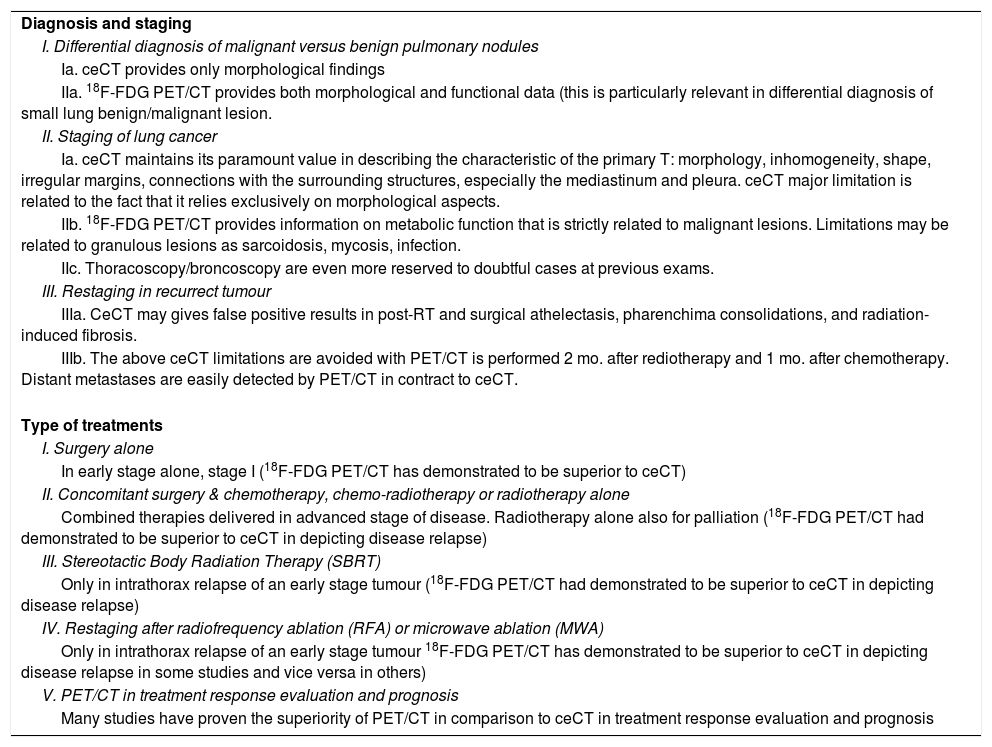Lung cancer is a fairly common malignancy. An early diagnosis and a reliable staging and re-staging with the aim to detect both local and distant relapse are of utmost importance in planning the therapeutic management. The imaging diagnostic work-up of patients with lung cancer usually includes conventional imaging (chest X-ray, contrast-enhanced CT , bone scan) and more recently 18F-FDG PET/CT. Great advances in the management of lung cancer are based on the information provided by 18F-FDG PET/CT, as it supplies both metabolic and anatomic information (better localisation). There is vast evidence in the literature demonstrating its utility in (a) characterising benign versus. malignant solitary nodules, (b) staging and re-staging lung cancer, (c) guiding the type of therapy, (d) monitoring treatment response and (e) predicting outcome. In particular, given its specificity in differentiating 18F-FDG-avid relapse from post-surgical changes or post-radiation fibrosis (which do nott take up 18F-FDG), PET/CT can detect recurrent disease after initial treatment and (being a whole-body technique) and has demonstrated high accuracy in the detection of distant metastases or secondary tumours. In conclusion, 18F-FDG PET/CT can be considered a highly accurate and reliable method for staging and re-staging lung cancer, and is highly effective in guiding personalised therapies.
El cáncer de pulmón es una neoplasia maligna bastante común. Un diagnóstico precoz y una estadificación y re-estadificación confiables, con el objetivo de detectar recaídas tanto locales como distantes, son de suma importancia en la planificación del manejo terapéutico. La evaluación diagnóstica de los pacientes con cáncer de pulmón generalmente incluye imágenes convencionales (radiografía de tórax, TC con contraste, gammagrafía ósea) y, más recientemente, PET/TC con 18F-FDG. El gran avance en el manejo del cáncer de pulmón derivado de la PET/TC con 18F-FDG proporciona información tanto metabólica como anatómica (mejor localización): existe una gran evidencia en la literatura que demuestra su utilidad en a) caracterizar nódulos solitarios benignos versus malignos, b) estadificación del cáncer de pulmón y re-estadificación, c) guía del tipo de terapia, d) seguimiento de la respuesta al tratamiento, e) predicción de resultados. En particular, gracias a su especificidad en la diferenciación de la recidiva con avidez por 18F-FDG de los cambios postquirúrgicos o de la fibrosis posradiación (que no captan 18F-FDG), la PET/TC puede detectar una enfermedad recurrente después del tratamiento inicial y (siendo una técnica de cuerpo completo ) y demuestra una alta precisión en la detección de metástasis a distancia o tumores secundarios. En conclusión, la PET/TC con 18F-FDG se puede considerar un método altamente preciso y confiable para estadificar y re-estadificar el cáncer de pulmón, y es muy eficaz para guiar terapias personalizadas.
Article
If you experience access problems, you can contact the SEMNIM Technical Secretariat by email at secretaria.tecnica@semnim.es or by phone at +34 619 594 780.

Revista Española de Medicina Nuclear e Imagen Molecular (English Edition)






